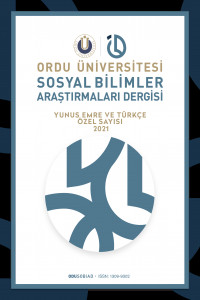Öz
Yunus Emre is one of those who played the most important role in the birth of a new literary language in Anatolia in the 13th century. In addition, based on her poems, it is possible to say that Yunus Emre knew Arabic, Persian, Islamic sciences, Islamic history and all the sciences of the period well. Yunus Emre is the sufi folk poet who expressed the subtleties of Islamic mysticism with simplicity. In this study, Yunus Emre's Divân-ı İlâhiyat has been examined as a source work. The aim of the study is to determine the terms of astronomy, metal and music in the vocabulary of the work called Dîvân-ı Theology. It is also trying to examine whether it is witnessed in the works of historical periods revealed until the thirteenth century. The work was scanned, the terms of astronomy, metal, and music instrument in the vocabulary were determined, the number of pages, ghazal and couplet numbers of the couplets in which the terms are included are shown right next to it. Thirteen (13) terms have been identified as astronomy terms. Eight (8) of these terms are in Arabic. These terms are: Moon (T), Bedr (A), Crescent (A), Earth (A), Falek (A), Sky (T), Sun (T), Shams (A), Yıldız (T), Ilduz (T), Mirrîh (A), Bercîs (A), Zühre (A). Fourteen (14) terms were identified as mineral terms. Five (5) of these terms are Arabic and three (3) are Persian. These terms are: Gold (T), Copper (T), Ore (A), Iron / Iron (T); Gevher (F), Güher (F), Kân (F), Sadef, (A); Silver (T), Pearl (T), Metal (A), Coral (A), Bronze (T), Ruby (A). Six (6) terms have been identified as musical instrument terms. One (1) is Arabic, three (3) are Persian, two (2) are Turkish. Rebab (A), Şeşte / Şeşta (F), Ceng (F), Çalgu (T), Saz (F), Kopuz (T).
Anahtar Kelimeler
Ynus Emre ,Divân-ı Theology ,astronomy ,mine ,musical ,terms
Kaynakça
- 1. Aksan, D.(2015),Türkçenin Sözvarlığı, İstanbul: Bilgi Yayınevi.
- 2. Arat, R. R.(1979), Kutadgu Bilig III-İndeks, İndeksi haz. Kemal Eraslan-Osman F.Sertkaya-Nuri Yüce, İstanbul: Türk Kültürünü Araştırma Enstitüsü.
- 3. Arat, R. R. (1992), Edib Ahmed B. Mahmud Yükneki- Atebetü’l- Hakayık, Ankara: TDK Yay.
- 4. Atalay. B. (1999), Dîvânu Lugâti’t-Türk Dizini “Endeks”- Cilt IV, Ankara: TDK Yay.
- 5. Banarlı, N. S. (1971),Resimli Türk Edebiyatı Tarihi, İstanbul: MEB Yay.
- 6. Develioğlu, F.(2016), Osmanlıca-Türkçe Ansiklopedik Lûgat, Ankara: Aydın Kitâbevi.
- 7. Gölpınarlı, A.(2015), Yunus Emre, İstanbul: Kapı Yay.
- 8. Özçelik, S. (2016),Dede Korkut-Dresden Nüshası-Metin, Dizin-II. Cilt, Ankara: TDK Yay.
- 9. Şirin, H. (2016),Eski Türk Yazıtları Söz Varlığı İncelemesi, Ankara: TDK Yay.
- 10. Tatçı, M.(2014), Yunus Emre-Dîvân-ı İlâhiyât, İstanbul: h yayınları.
- 11. Tekin, T. (2013), Irk Bitig-Eski Uygurca Fal Kitabı, Ankara: TDK Yay.
- 12. Timurtaş, F. K. (2012),Yunus Emre Divânı, İstanbul: Kapı Yay.
- 13. Yılmaz, F.(1992), Yunus Emre-Hayatı-Düşüncesi-Etkisi, İstanbul: Marifet Yay.
- 14. Zülfikar, H. (2011),Terim Sorunları ve Terim Yapma Yolları, Ankara: TDK Yay.
Öz
XIII. yüzyılda Anadolu’da yeni bir edebiyat dilinin doğuşunda en mühim rolü oynayanlardan biri de Yunus Emre’dir. Ayrıca şiirlerinden hareketle Yunus Emre’nin, Arapça, Farsça, İslâmî ilimler, İslam tarihi ve devrin bütün ilimlerinden haberdâr olduğunu söylemek mümkündür. İslam tasavvufunun inceliklerini sadelikle dile getirmiş mutasavvıf halk şairi Yunus Emre’dir. Bu çalışmada, Yunus Emre’nin Divân-ı İlâhiyat adlı eseri kaynak eser olarak incelenmiştir. Çalışmanın amacı, Divân-ı İlahiyat adlı eserin sözvarlığı içerisinde yer alan astronomi, maden ve musıkî âleti terimlerini tespit etmektir. On üçüncü yüzyıla kadar ortaya konulmuş tarihî dönemlere ait eserlerde tanıklanıp tanıklanmadığı da incelemeye çalışmaktır. Eser taranmış, söz varlığı içerisinde yer alan astronomi, maden, musıkî âleti terimleri tespit edilmiş, terimlerin yer aldığı beyitlerin sayfa sayısı, gazel ve beyit numarası hemen yanında gösterilmiştir. Astronomi terimleri olarak, on üç (13) terim tespit edilmiştir. Bu terimlerden sekizi (8) Arapçadır. Bu terimler şöyledir: Ay (T), Bedr (A), Hilâl (A), Dünya (A), Felek (A), Gök (T), Güneş (T), Şems (A), Yıldız (T), Ilduz (T), Mirrîh (A), Bercîs (A), Zühre (A). Maden terimleri olarak on dört (14) terim tespit edilmiştir. Bu terimlerden beşi (5) Arapça, ikisi (2) Farsçadır. Bu terimler; Altun (T), Bakır (T), Cevher (A), Demir / Demür (T); Gevher (F), Güher (F), Kân (F), Sadef, (A); Gümüş (T), İnci (T), Maden (A), Mercan (A), Tunç, Yakut (A)’tur. Musikî terimleri olarak altı (6) terim tespit edilmiştir. Biri (1) Arapça, üçü (3) Farsça, ikisi (2) Türkçedir. Bu terimler, Rebâb (A), Şeşte /Şeştâ (F), Ceng (F), Çalgu (T), Saz (F), Kopuz (T)’dur.
Anahtar Kelimeler
Yunus Emre ,Divân-ı İlâhiyat ,astronomi , maden ,musikî ,terimler
Kaynakça
- 1. Aksan, D.(2015),Türkçenin Sözvarlığı, İstanbul: Bilgi Yayınevi.
- 2. Arat, R. R.(1979), Kutadgu Bilig III-İndeks, İndeksi haz. Kemal Eraslan-Osman F.Sertkaya-Nuri Yüce, İstanbul: Türk Kültürünü Araştırma Enstitüsü.
- 3. Arat, R. R. (1992), Edib Ahmed B. Mahmud Yükneki- Atebetü’l- Hakayık, Ankara: TDK Yay.
- 4. Atalay. B. (1999), Dîvânu Lugâti’t-Türk Dizini “Endeks”- Cilt IV, Ankara: TDK Yay.
- 5. Banarlı, N. S. (1971),Resimli Türk Edebiyatı Tarihi, İstanbul: MEB Yay.
- 6. Develioğlu, F.(2016), Osmanlıca-Türkçe Ansiklopedik Lûgat, Ankara: Aydın Kitâbevi.
- 7. Gölpınarlı, A.(2015), Yunus Emre, İstanbul: Kapı Yay.
- 8. Özçelik, S. (2016),Dede Korkut-Dresden Nüshası-Metin, Dizin-II. Cilt, Ankara: TDK Yay.
- 9. Şirin, H. (2016),Eski Türk Yazıtları Söz Varlığı İncelemesi, Ankara: TDK Yay.
- 10. Tatçı, M.(2014), Yunus Emre-Dîvân-ı İlâhiyât, İstanbul: h yayınları.
- 11. Tekin, T. (2013), Irk Bitig-Eski Uygurca Fal Kitabı, Ankara: TDK Yay.
- 12. Timurtaş, F. K. (2012),Yunus Emre Divânı, İstanbul: Kapı Yay.
- 13. Yılmaz, F.(1992), Yunus Emre-Hayatı-Düşüncesi-Etkisi, İstanbul: Marifet Yay.
- 14. Zülfikar, H. (2011),Terim Sorunları ve Terim Yapma Yolları, Ankara: TDK Yay.
Ayrıntılar
| Birincil Dil | Türkçe |
|---|---|
| Konular | Dil Çalışmaları |
| Bölüm | ARAŞTIRMA MAKALESİ |
| Yazarlar | |
| Yayımlanma Tarihi | 27 Aralık 2021 |
| Gönderilme Tarihi | 5 Temmuz 2021 |
| Yayımlandığı Sayı | Yıl 2021 Sayı: Özel Sayı (Yunus Emre ve Türkçe) |
Bilginin ışığında aydınlanmak dileğiyle....
ODÜSOBİAD


